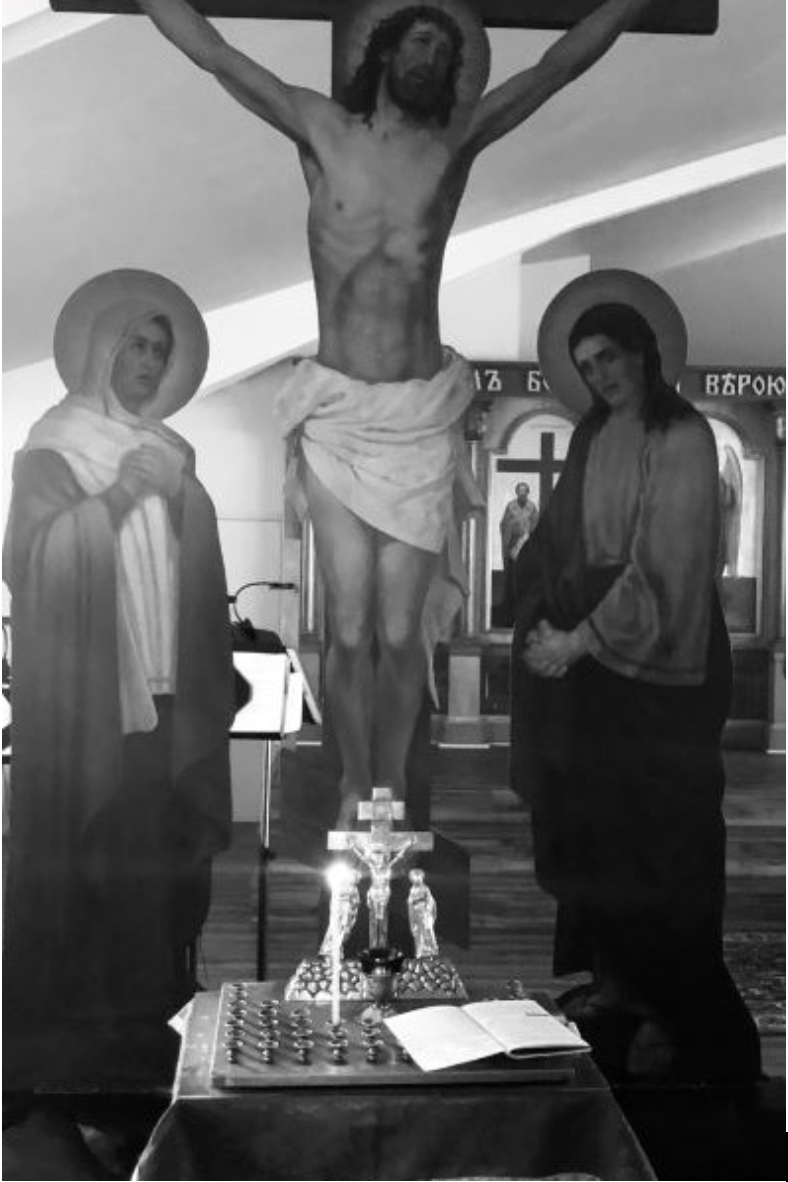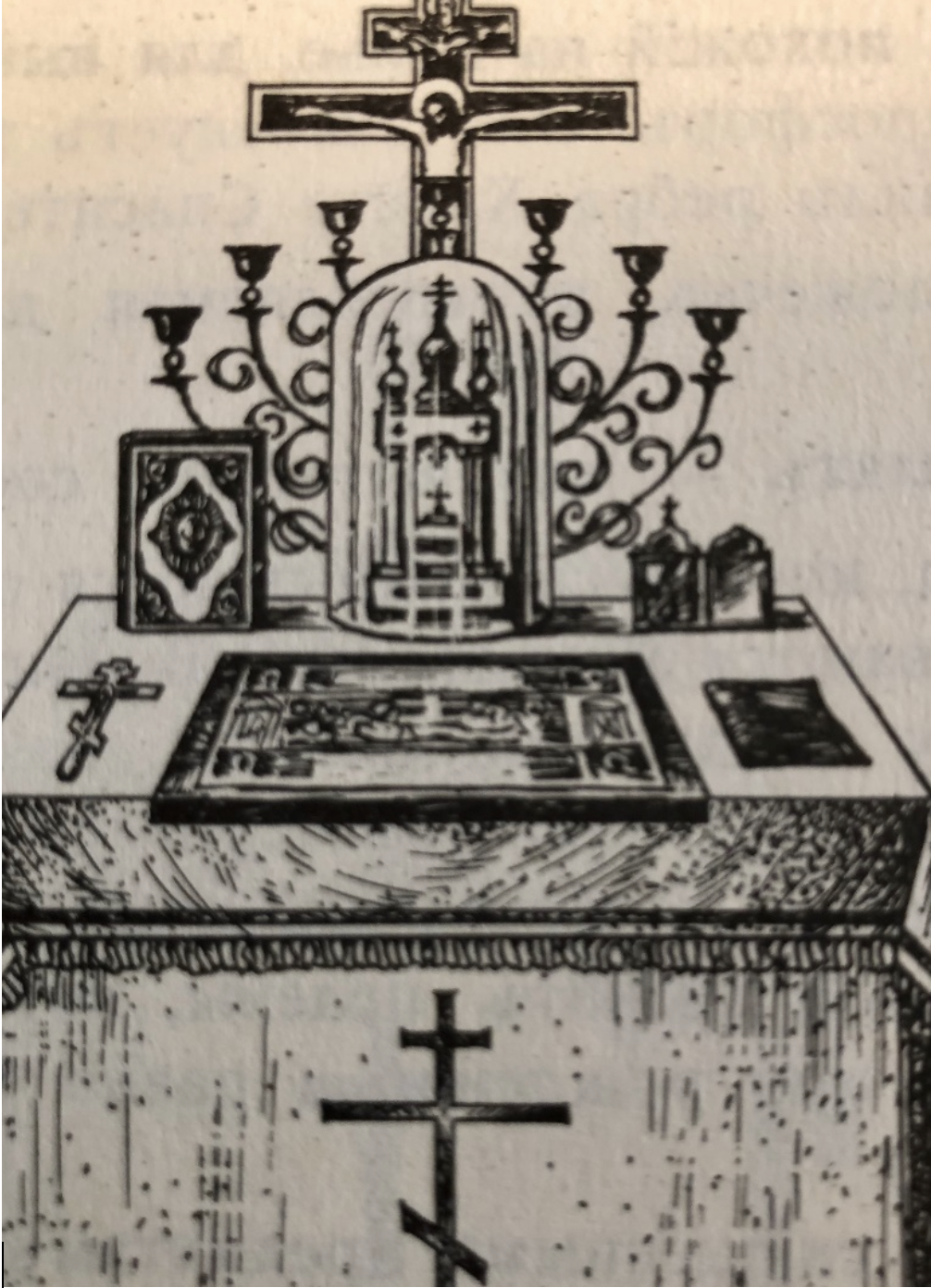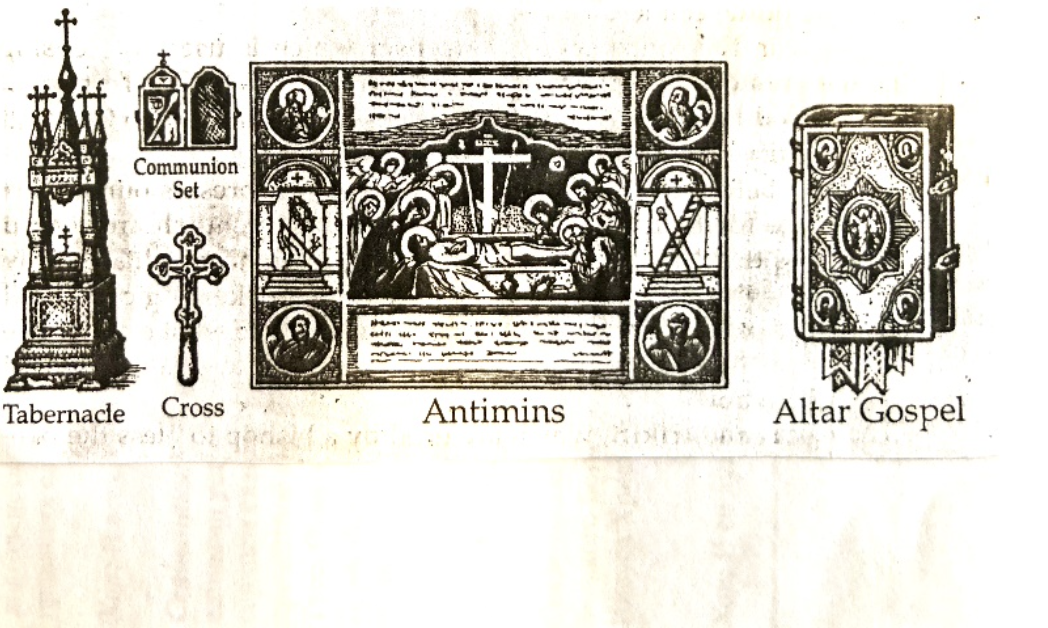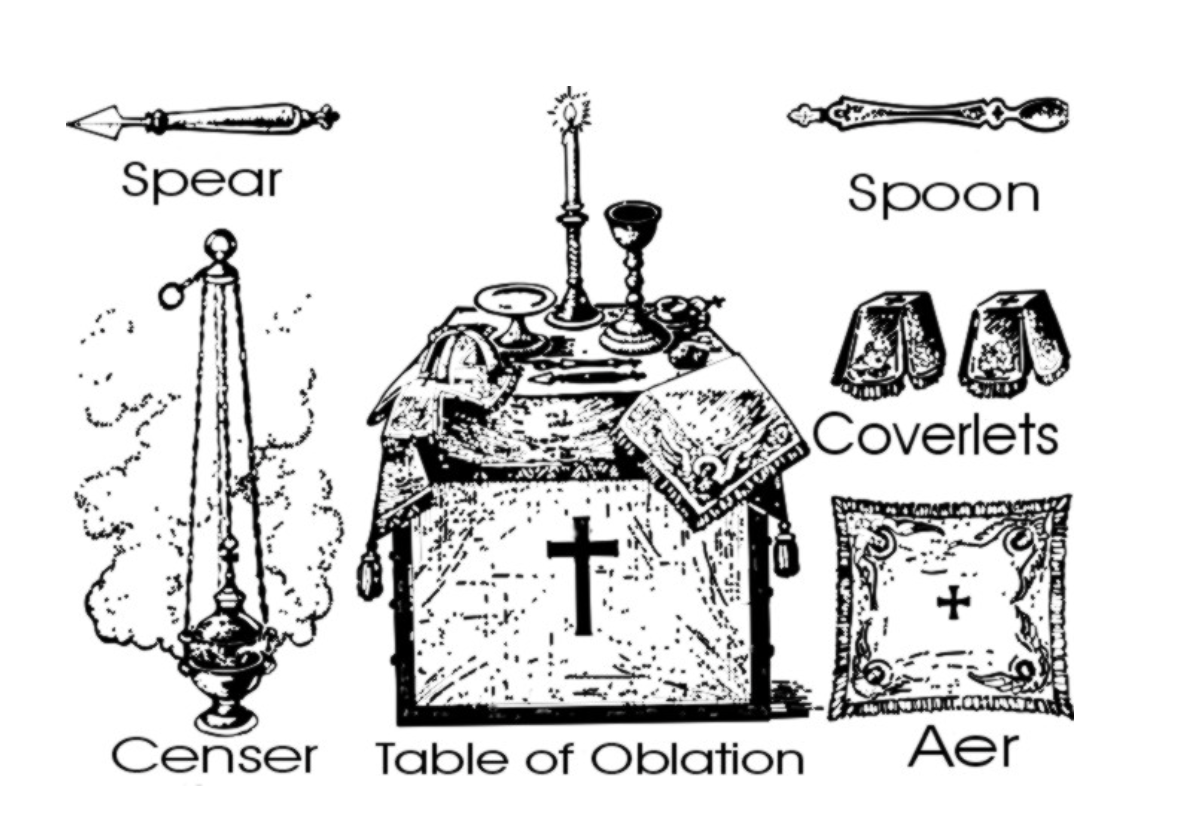The House of God
by Archpriest Alexander Lebedeff and translated from Russian by V. Rev. Anatole Lyovin
Basic Concepts Concerning Orthodox Church and How Orthodox Christians Should Behave in Church
What is an Orthodox Church?
An Orthodox church is the house of God. In it, various services are held, the Gospel is read, in it we hear sermons which direct us toward our salvation and eternal life in the Kingdom of Heaven.
Everything in this church is special. Everything in it is designed to spur us to prayer and thoughts about God and His boundless love towards us. In the church we can see many holy icons which not only represent the saints but which, in Orthodox understanding, happen to serve also as “windows to Heaven”, through which we are transported from this temporary life to Heaven and eternal bliss.
What does an Orthodox Church look like?
At first glance it may appear that the churches are all very different from each other. There are very majestic churches and very small ones, wide ones and very narrow ones. There are churches which have only one cupola whereas many churches have a multitude of cupolas. However, regardless of all these visible differences an Orthodox church both outside and inside is arranged according to very definite rules; thus, one can immediately recognize it as an Orthodox church and not some other kind of building. The churches have various forms. Most often one can see churches whose foundations have the shape of an elongated rectangle. The shape of such a church simbolically represents a ship by means of which we sail over the stormy waves of “the sea of life” towards the final haven in the Kingdom of Heaven.
What do we see when we enter the church?
On entering an Orthodox church we usually find ourselves in the first part of the church which has three parts – the narthex. Sometimes the narthex is separated from the rest of the church by a glass partition with doors. However, there is no partition whatsoever. In any case, at the right side of the narthex, there is often a candle stand where candles are sold, the prosphoras are ordered, and offerings are received for the support of the church and the clergy. Usually, the candle stand is manned by the ‘starosta’ (the warden or president of the church council) someone who is elected by all the members of the parish to serve as the first lay helper of the church to the rector of the parish (the chief priest who is appointed by the ruling church hierarch to be the head of the parish). The starosta is the head of the parish responsible for the housekeeping matters of the parish, for keeping order during theservices and cross processions, for the decoration and cleaning of the church itself and the church yard. Usually the parish also elects various people who help the warden in his duties, as well as the treasurer of the parish who receives monetary donations, deposits them in the bank accounts, writes the checks to cover all the necessary expenditures as well as records all the income and expenses in a ledger and formulates financial statements.
After the narthex there is a middle, basic part of the church where the faithful stand during the services. In this part of the church stand various “analogia” (high stands covered with cloth) on which icons are placed and candle holder stands where lighted candles are placed. Usually to the side there also stands a large crucifix with a representation of the crucifed Christ on it. In front of that cross there usually is a “pannikhida table” where the pannikhida memorial services are held for the reposed Orthodox Christians.
In the church we may also see church banners, especially made flags which are adorned with various icons. These banners are mounted on poles and are carried out during the cross processions. [Transl. Note: In our church we have such a banner hanging on the wall in the altar. It has an icon of Saint Nicolas on one side and an icon of the Holy Resurrecion on the other. This banner is an antique and is mounted within a glass case; thus, it is not carried in processions.]
Close to the walls of the church, and sometimes in other places, there are “kiots” standing icon holding constructions decorated with wood carvings which contain icons that deserve highest veneration.

On entering the church we see in front of us a specially decorated barrier – “Iconostasis” (Icon Screen) which separates the middle of the church from the most sacred part of the church – the altar. Altar area may be entered only by the clergy and their assistaants – altar boys as well as the warden of the parish and his assistants, but the latter may enter only after receiving the blessing of the rector to do so. Women render their services to the church as readers, choir members, and by cleaning and decorating the church. [Transl. Note: Women, with certain rare exceptions, are not permitted to enter the altar area at all.]
The icon screen contains a large number of icons which are arranged on it according to the rules established by the Church. The icon screen has three entrances. The central doors are called “The Royal Doors,” and only clergymen are allowed to go through them. These doors are usually closed and are opened only during the especially solemn parts of the service. Behind the Royal Doors there is a curtain which is also opened and closed depending on the importance of a particular moment in the service. To the right and the left there are side doors which are sometimes called “Deacons’ Doors” since most often it is the deacon who exits from the altar and enters them in order to chant the prayers in the name of all the faithful.

In the middle of the altar stands the Holy Altar on which the Divine Liturgy is celebrated. On it are found the Holy Gospel and the Cross, as well as the “Darokhranitel’nitsa” or Tabernacle in which the reserved Holy Gifts are kept for communing the sick. Behind the altar or on the back part of it there stands the Seven Candle Stand (which resembles the Jewish “menorah”). Only the clergy (i.e. subdeacons and above) are allowed to touch the Altar.
On the Altar, besides the Gospel and crosses there is also Antimension or Antimins, a cloth with the icon that depicts Christ being taken from the Cross. It is unfolded during the liturgy just before the Holy Gifts are transferred to it from the Table of Oblation.


In the left corner of the ltar area there stands another square table – the Table of Oblation or Sacrifice – on which the priest prepares everything that is needed for serving the Holy Liturgy. This is where the priest prayerfully remembers the names of the living and the dead and takes small fragments of bread from the prosphoras. During the Great En-trance at the Liturgy the prepared Holy Gifts are transferred from the Table of Oblation to the Holy Altar.
The entire altar area is usually slightly raised up from the rest of the church as a sign of the sacredness of the services which are served in it. This raised floor continues even out of the altar area especially in front of the altar and the iconostasis as a whole. This raised portion of the floor is called “solea,” and its front part, usually forming a semicircle, is called “ambo.” The priest comes out of the Royal Doors to the ambo to deliver the sermon.
On the two sides of the solea one often finds specially constructed areas called “kliros” where readers read the designated psalms and other prayers, and the choir members sing during weekday services. On Sundays and special holidays, the choir usually sings on the choir loft at the back of the church.
According to the rules of the Orthodox Church, the Royal Doors are supposed to face the East form where the Sun rises since our Lord Jesus Christ is called “the Sun of Justice which rises in the East.” but outside of traditionally Orthodox lands for various reasons it is difficult to find churches that actually follow that rule.
How should one behave in the church?
First of all, one must come to church dressed appropriately. That does not mean that one should dress in the most expensive and fashionable clothing. However, one must wear clean Sunday best clothing. That means that one should not come to church wearing sport, work clothing or soiled clothing. In no case should one come to church wearing clothing which is more appropriate for the beach.
Men do not have to wear suits or neckties. However, the shirts must be with long sleaves (no T-shirts with designs or slogans of any kind!), the trousers should be fairly formal (no torn jeans!), and footwear should be ordinary footwear. Shorts may be worn only by boys no older than seven years.
Women should take care that their clothing is proper. Sleeveless dresses and blouses should not be worn, as well as such clothing that are too open either in front or behind. Skirts should be of appropriate length (no higher than one’s knees), without slits, and footwear should also be appropriate.
Women should also be careful in respect to cosmetics. It is desirable that cosmetics be used at a minimum, and especially avoid putting on too much lipstick which leaves oily red traces on the icons, on the cross, and on priest’s hands. It is especially inppropriate to approach the Holy Chalice with the lips covered with lipstick.
According to the Scriptures and according to the very ancient traditions of the Holy Church, women are supposed to cover their hair in the church. This rule – the sign of obedience and modesty—is nowadays only rarely observed.
One should come to church on time. [Transl. Note: According to church rule, those adults that come to church after the Gospel is read are denied Holy Communion, even if they are otherwise fully prepared for it.] Unless that is absolutely necessary one should not leave the church before the services are over.
In general, all movement around the church during the services interferes with prayer. In the church one should avoid all converstions, shaking of hands or hugs between women. One may greet one’s friends by quietly bending one’s head without saying anything.
[Transl. Note: It is especially important not to talk or otherwise socialize with friends during the kissing of the cross at the end of liturgy when special prayers are being said in gratitude for having received the Holy Gifts. Even if you did not receive the Holy Gifts you should not interfere with the prayers of those who have received them.] How does one make the sign of the cross?
As one enters the church (preferably before the beginning of the service) one should make the sign of the cross three times while making three waist deep bows. Before making each waist deep bow one should say silently, “Oh God be merciful to me a sinner.”
The sign of the cross should be made very carefully and correctly putting together the fingers of the right hand: the first three fingers – the thumb, the index finger and the middle finger should be joined together at their tips; and the other two – the fourth finger and the little finger – should be bent down and held against the palm. Having arranged the finger in this way one should place them first on the forehead, then to the top part of one’s stomach, then to the right shoulder, and finally, to the left shoulder. By doing this we make the sign of the cross on ourselves and ask God to enlighten our minds, strengthen our bodies, and to bless the labor of our hands. One should at all cost avoid making the sign of the cross carelessly and with undue haste.
[Transl. Note: The three first fingers represent the mystery of the Holy Trinity ‘three and yet one.’ The last two fingers represent the dual nature of Christ: ‘perfect God and perfect man.’]
After making the three waist bows at the entrance – which one is supposed to repeat at the exit of the church, of course, facing the altar – the faithful usually approach the candle kiosk where they purchase candles. There are many different sizes of candles – from the very small to the very large ones. While buying candles one should avoid having unnecessary conversations and one should also be careful not to drop any coins on to the table or the floor because such noises distract the faithful from their prayers. How should children behave in the church?
It is imperative that you should always bring your children to church in order that they may get used to the divine services. Our Lord said, “Suffer the little children to come unto Me.” We should be glad to see children in the church and remember that children are our future. At the same time, parents should teach their children to behave and comport hemselves quietly in the church. They should not be allowed to run around the church but should stand quietly near their parents. Of course, one cannot expect the children to be always quiet. If a child begins to cry the parents should try to calm the child down. If the child does not calm down but continues crying aloud, it should be carried out of the church lest it disturb the devout atmosphere of the service. Later, after the child calms down, it should be brought back into the church. One should not bring children’s toys into the church in order to amuse the children during the services. It is also not allowed to give children a key ring or any jingling object that may distract the faithful from their prayers during the services.
Can one sit in the church?
In traditional Orthodox churches (including Greek churches in Greece) one should stand during the services. One should stand up straight and attentively listen to the prayers and hymns. It is absolutely inappropriate to put one’s hands in the pockets. For the very old and infirm there are usually either chairs or benches placed along the back wall. If it is absolutely necessary to sit because one is extremely tired one should sit up straight without crossing one’s legs, which is absolutely not allowed in a church. Of course, during the most important parts of the service one should not sit (for example, during the reading of the Gospel). Some faithful observe that the priest sits in the altar during the reading of the Epistle (which is read just before the reading of the Gospel during the Liturgy) and conclude that they are also allowed to sit during the reading of the Epistle. This conclusion is wrong since the priest sits during the reading of the Epistle as a sign of his apostolic succession and right to preach the Word of God, just as the apostles did. However, the lay believers do not have this right, and hence they ought to stand during the reading of the Epistle.
What is a prosphora?
In fully established churches there is at the entrance a little kiosk manned by a parishioner where one may buy candles or order prosphoras, special little bun like breads, but the latter can be ordered only when there is a liturgy scheduled for that day. (Usually this is in the morning.)
[Transl. Note: In our church there is yet no such kiosk, and you cannot order a prosphora. You may buy candles and deposit the money in a special donation box which is placed nearby. Also, you may ask that your commemorative list be taken by an altar boy into the altar for commemoration.]
Prosphora in Greek means ‘offering,’ and in ancient times the believers use to bring to church actual loaves of bread which they themselves baked at home. These days the prosphoras are baked by specially appointed parishioners (usually older women), and parishioners may buy them at the candle kiosk.
Together with the prosphoras, parishioners prepare special memorial lists which contain the names of all the living and all the reposed persons that a parishioner wants the priest to commemorate (pray for) during the prayers of proskomedia (preparation of the Holy Gifts).
These commemoration lists are usually available in two variants: commemoration lists for health of the living (with the title printed in red) and lists for the repose of the dead (with the title in printed in black).
Of course, if such printed lists are not available, the names can be written on ordinary paper pages, but each separate paper should be entitled either as ‘For the Health’ (i.e. ‘For the Living’) or ‘For the Repose’ (‘For the Dead’). One should never write the names of both the living and the dead on the same list without differentiating between them.
The names should be written in their full form and without patronymics (as in the case of Russian names) or surnames. [Transl. note: only the baptismal names in their full form should be used. For example, instead of ‘Sandy’ one should use ‘Alexander.’]
The clergymen’s names should be preceded by their official rank: ‘Archbishop Kyrill,’ ‘Archpriest Anatole,’ ‘Deacon Nectarios,’ and not ‘Vladyka Kyrill,’ ‘Father Anatole’ etc. Abbreviations of titles are allowed as long as they disambiguate between various titles. Thus, since ‘arch.’ can stand for either ‘archbishop’ or ‘archdeacon’ one should write ‘archb.’ For ‘archbishop’ and ‘archd.’ For ‘archdeacon.’